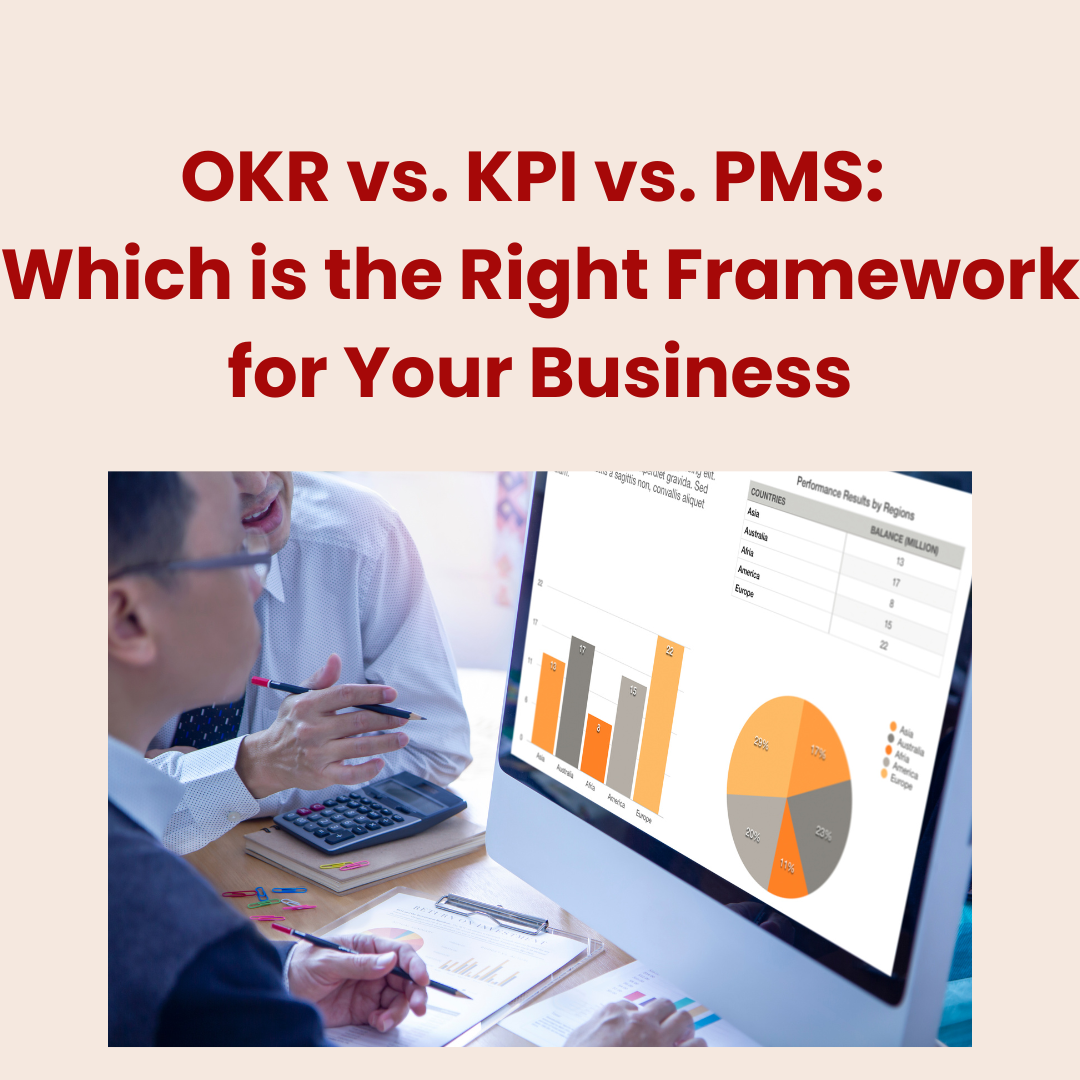In today’s fast-paced world, business owners and coaches must understand OKRs (Objectives and Key Results), KPIs (Key Performance Indicators), and PMS (Performance Management Systems) to drive growth and performance. Whether you’re running a company or coaching leaders, mastering these frameworks helps create clarity, accountability, and alignment.
1. What Are OKRs, KPIs, and PMS?
✅ OKR (Objectives and Key Results)
OKRs are a powerful goal-setting framework used to define ambitious objectives and measure progress through key results. They encourage focus, alignment, and continuous improvement.
- Objective: A clear, inspirational goal (e.g., “Expand into the Southeast Asian market”).
- Key Results: Measurable outcomes to track success (e.g., “Launch in three new countries by Q3,” “Increase regional sales by 20%”).
- Best for: Driving strategic growth and transformation.
✅ KPI (Key Performance Indicator)
KPIs are metrics that track the performance of specific activities. Unlike OKRs, which focus on what needs to change, KPIs measure ongoing performance.
- Example KPIs:
- Sales growth rate
- Customer retention rate
- Employee engagement score
- Website traffic
- Best for: Measuring operational efficiency and stability.
✅ PMS (Performance Management System)
A PMS is a structured approach to managing employee performance, development, and feedback. It includes OKRs and KPIs but also focuses on performance reviews, coaching, and rewards to ensure employees stay on track.
- Components of a PMS:
- Goal setting (OKRs/KPIs)
- Continuous feedback and coaching
- Performance evaluations
- Employee rewards and development
- Best for: Managing individual and team performance.
2. Key Differences Between OKRs, KPIs, and PMS
| Feature | OKR | KPI | PMS |
|---|---|---|---|
| Purpose | Drives strategic focus and growth | Tracks operational performance | Manages overall employee performance |
| Timeframe | Quarterly or annual | Ongoing (weekly/monthly/quarterly) | Long-term (yearly/continuous) |
| Measurement | Achieving objectives via key results | Monitoring metrics against targets | Employee progress & development |
| Flexibility | Adaptable, ambitious goals | Fixed, consistent measures | Process-driven & structured |
| Ownership | Teams and individuals | Departments or functions | HR, leadership, and management |
3. How Coaches Can Teach This to Clients and Teams
A. Teaching OKRs: How to Set Bold and Achievable Goals
🔹 Help business owners and teams craft inspiring objectives (e.g., “Become the #1 fitness brand in Malaysia”).
🔹 Guide them in setting measurable key results (e.g., “Increase app downloads by 50%, grow Instagram engagement by 30%”).
🔹 Encourage alignment across departments—everyone should contribute to the same bigger goal.
✅ Coaching Tip: Use real-world examples and role-playing exercises to help clients write their own OKRs.
B. Teaching KPIs: How to Measure What Matters
🔹 Explain that KPIs are not just numbers—they must be relevant to business success (e.g., a restaurant tracking table turnover rate).
🔹 Help them identify leading vs. lagging indicators (e.g., social media engagement is a leading indicator for future sales).
🔹 Ensure they track KPIs regularly and adjust strategies accordingly.
✅ Coaching Tip: Show how KPIs can reveal problem areas and help businesses make data-driven decisions.
C. Teaching PMS: How to Manage Performance Effectively
🔹 Guide leaders on providing continuous feedback instead of just annual reviews.
🔹 Help businesses implement structured coaching and mentorship for employees.
🔹 Teach how to use performance data to develop talent and increase engagement.
✅ Coaching Tip: Run workshops on how managers can give constructive feedback using real-life scenarios.
4. How These Frameworks Work Together
The most successful businesses combine OKRs, KPIs, and PMS to create a well-rounded system:
- OKRs set ambitious goals (e.g., “Improve customer satisfaction across all channels”).
- KPIs measure progress (e.g., “Increase Net Promoter Score (NPS) from 50 to 75”).
- PMS ensures employees stay on track by providing feedback, coaching, and incentives.
Case Study: How Google Uses OKRs, KPIs, and PMS
Google is famous for using OKRs to drive innovation.
Example OKR:
- Objective: Become the world’s most trusted AI-powered search engine.
- Key Results:
- Increase AI-generated search accuracy to 95%.
- Improve response time for AI queries by 30%.
- Gain 20 million active users for AI search by year-end.
At the same time, Google tracks KPIs such as website traffic and user engagement. Their PMS ensures employees receive continuous feedback, career development, and performance incentives.
✅ Coaching Tip: Use this case study in workshops to help clients see how these frameworks apply in real life.
5. Common Mistakes and How to Avoid Them
🔴 Confusing KPIs with OKRs – KPIs are metrics, but OKRs are about driving change.
🔴 Setting too many OKRs or KPIs – Focus on 3-5 key goals to avoid overwhelm.
🔴 Neglecting feedback in PMS – Performance management isn’t just about numbers; it’s about people development.
✅ Coaching Tip: Ask clients to identify one key action they will take to improve their OKRs, KPIs, or PMS.
Conclusion: A Framework for Success
For business owners, using OKRs, KPIs, and PMS helps drive results and keep teams aligned.
For coaches, understanding these frameworks allows you to guide clients toward better goal-setting, tracking, and performance management.
By implementing these frameworks effectively, organizations can create a culture of accountability, innovation, and continuous improvement. 🚀


